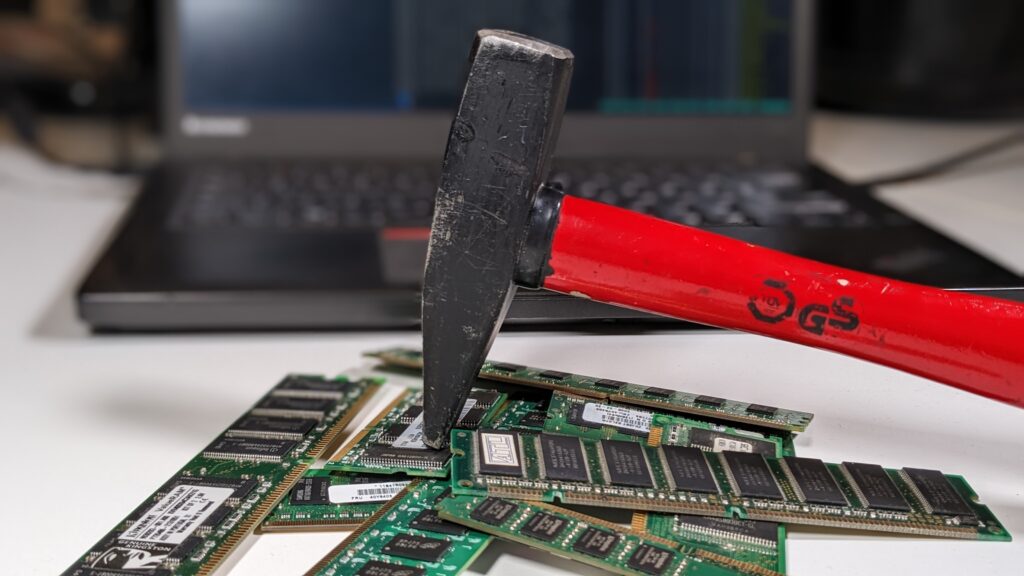NeRAM - Next-Generation Rowhammer Attacks and Mitigations
Beschreibung
DRAM speichert Daten in Speicherzellen, in Arrays aus Kondensatoren und Transistoren. Hersteller erhöhen ständig die Dichte dieser Arrays, um Speicherkapazität, Leistung und Effizienz zu optimieren. Die Dichte ist so hoch, dass ein schnelles Lesen Bit-Flips in benachbarten Speicherzeilen verursachen kann. Die Ausnutzung dieses Rowhammer-Effekts kann die Speicherisolation und damit die Systemsicherheit untergraben. In den letzten Jahren ist Rowhammer aus zwei Gründen zu einem größeren Sicherheitsproblem geworden: Erstens hat sich die Anzahl der für einen Angriff erforderlichen Zugriffe um den Faktor 30 verringert. Zweitens wurden in vorheriger Forschung verschiedene Wege gefunden um Rowhammer in Privilege-Escalation Angriffen auszunutzen. Drittens
wurden frühere Versuche Rowhammer zu verhindern in aktueller Forschung bereits umgangen.
Wie oben beschrieben, sind der Rowhammer-Effekt und seine Auswirkungen in vielen Anwendungen und Umgebungen noch nicht vollständig verstanden. Dieses Forschungsprojekt schließt diese Verständnislücken, indem wir den Rowhammer Effekt und effektive Rowhammer-Abwehrmaßnahmen untersuchen und entwickeln.
Fiedler, Carina; Juffinger, Jonas; Sudheendra , Raghav Neela; Heckel, Martin; Weissteiner, Hannes; Yağlıkçı, Abdullah Giray; Adamsky, Florian; Gruss, Daniel (2026)
Fiedler, Carina; Juffinger, Jonas; Sudheendra , Raghav Neela; Heckel, Martin...
Network and Distributed System Security (NDSS) Symposium.
Rowhammer
bit flips in DRAM enable software attackers to fully compromise a great
variety of systems. Hardware mitigations can be precise and efficient
but suffer from long deployment cycles and very limited or no update
capabilities. Consequently, refined attack methods have repeatedly
bypassed deployed hardware protections, repeatedly leaving commodity
systems vulnerable to Rowhammer attacks. In this paper, we present Memory Band-Aid, a principled
defense-in-depth against Rowhammer. Memory Band-Aid is no replacement
for long-term, efficient hardware mitigations but a defense-in-depth
that is activated when hardware mitigations are discovered to be
insufficient on a specific system generation. For this purpose, Memory
Band-Aid introduces per-thread and per-bank rate limits for DRAM
accesses in the memory controller, ensuring that the minimum number of
row activations for Rowhammer bit flips cannot be reached. We implement a
proof-of-concept of Memory Band-Aid on Ubuntu Linux and test it on 3
Intel and 3 AMD systems. In a micro-benchmark to cause DRAM pressure, we
observe a slow down up to a factor of 5.2. In a collection of realistic
Phoronix macro-benchmarks, we observe a low overhead of 0 % to 9.4 %.
Both overheads only apply to untrusted throttled workloads, e.g.,
sandboxes, for instance in browsers. Especially as Memory Band-Aid can
be enabled on demand, we conclude that Memory Band-Aid is an important
defense-in-depth that should be deployed in practice as a second defense
layer.A Principled Rowhammer Defense-in-Depth
Open Access
Peer Reviewed
Heckel, Martin; Adamsky, Florian (2025)
1st Microarchitecture Security Conference (uASC '25).
The density of memory cells in modern DRAM is so high that frequently accessing a memory row can flip bits in nearby rows. That effect is called Rowhammer, and an attacker can exploit this phenomenon to flip bits by rapidly accessing the contents of nearby memory rows. In recent years, researchers have developed sophisticated exploits based on this vulnerability, which enable privilege escalation on desktop computers, mobile devices, and even cloud systems without requiring any software vulnerability. However, rows are not equally vulnerable to Rowhammer. Therefore, an attacker has to massage the memory, for instance, with Page Table Entry (PTE) spraying, to increase the chance of successful exploitation. More bit flips mean the attacks become easier and faster to conduct. In this paper, we present Flipper, a Rowhammer amplification attack against DDR3, consisting of two components: cmpIST exploits the cmpsb and repe x86 instructions to get DRAM access with higher frequency. cmpP AR exploits the effect of hammering in multiple threads, which increases the number of bit flips found in a given time, as shown in previous work. As a result, we can increase the number of bit flips by a factor of 830 on the measured devices, even on systems featuring mitigation techniques, without using administrative privileges. We evaluate our technique on six DDR3 DIMMs. Although DDR3 memory has been superseded by DDR4 and DDR5 memory technologies, it is still widely used in devices that do not require frequent replacement, such as projectors, smart displays, servers, embedded devices, routers, and printers. Flipper: Rowhammer on Steroids
DOI: 10.46586/uasc.2025.002
Open Access
Peer Reviewed
Juffinger, Jonas; Sudheendra , Raghav Neela; Heckel, Martin; Schwarz, Lukas; Adamsky, Florian; Gruss, Daniel (2024)
Juffinger, Jonas; Sudheendra , Raghav Neela; Heckel, Martin; Schwarz, Lukas...
21st Conference on Detection of Intrusions and Malware & Vulnerability Assessment (DIMVA '24).
Modern DRAM is susceptible to fault attacks that undermine the entire system’s security. The most well-studied disturbance effect is Rowhammer, where an attacker repeatedly opens and closes (i.e., hammers) different rows, which can lead to bitflips in adjacent rows. Different hammering strategies include double-sided, hammering two rows sandwiching a victim row, and one-location, hammering a single row. One-location Rowhammer requires no physical address information, as any location in memory is mapped to a DRAM row, and no relation between rows is required for hammering. The recently discovered Rowpress differs from Rowhammer by not hammering rows but keeping them open longer, evident by a disjoint set of affected memory locations. In this paper, we examine the differences between four attack variants: one-location Rowhammer, a one-location Rowpress variant we developed, double-sided Rowhammer, and double-sided Rowpress on a set of 12 DDR4 modules. Our methodology is to hammer and press the exact same set of physical memory locations in all attack variants. Surprisingly, our results show that on 4 out of 12 DDR4 modules, we were only able to reproduce double-sided Rowhammer but none of the other attack variants. On 2 DDR4 modules, we were able to reproduce all attack variants. We find that the number of unique bitflip locations ranges from 161 to 15 612, when hammering the exact same set of physical memory locations. Our one-location Rowhammer attack induces roughly the same amount of bitflips as double-sided Rowhammer, however, only 61.8 % of bitflip locations overlap. We explain this by one-location Rowhammer inducing bitflips due to the Rowhammer as well as the Rowpress effect, making the differentiation of both methods difficult, therefore, calling it Presshammer. Based on our observed bitflips, we develop the first end-to-end one-location Rowpress attack. One-location Rowpress requires only minimal physical address information that an attacker can acquire through a same-row same-bank side-channel attack. Our end-to- end attack escalates to kernel privileges within less than 10 minutes.Presshammer: Rowhammer and Rowpress without Physical Address Information
Peer Reviewed
Heckel, Martin; Adamsky, Florian (2023)
The 3rd Workshop on DRAM Security (DRAMSec 2023), co-located with ISCA 2023.
The memory controller of the CPU uses bank addressing functions to
determine physical locations within DRAM DIMMs. There are many fields of
application for these addressing functions, particularly in security.
For exam- ple, many Rowhammer proofs-of-concept use bank addressing
functions to select addresses located on the same bank but in different
rows to produce row conflicts. AMD provides these addressing functions
for older CPU models. Hence, research on reverse-engineering addressing
functions mainly targeted Intel CPUs since Intel did not publish these
functions. However, AMD stopped to publish the DRAM addressing functions
several years ago. AMD manufactures roughly a third of the sold CPUs in
today’s CPU market. We analyze reverse- engineering tools for
addressing functions and find that they do not work with AMD CPUs,
hindering reverse-engineering at- tempts and Rowhammer attacks on
systems with AMD CPUs. In this paper, we introduce an approach to
reverse-engineer the addressing functions of AMD CPUs, which facilitates
future Rowhammer experiments on AMD CPUs.Reverse-Engineering Bank Addressing Functions on AMD CPUs
Open Access
Peer Reviewed
Dissertations
Next-Generation Rowhammer Attacks and Mitigations
| PhD student | Martin Heckel |
|---|---|
| Research focus | Informationssysteme |
| Duration | 2023-02-10 - 2025-11-30 |
| Scientific supervisor HS-Hof | Prof. Dr. Florian Adamsky |
| Institutions |
Institut für Informationssysteme (iisys) Forschungsgruppe System and Network Security (sns) Forschung und Entwicklung Hochschule für angewandte Wissenschaften, Hof |
| Scientific supervisor (extern) | Universität Graz | Prof. Dr. Daniel Gruss |

Projektleitung
Projektbearbeitung
T +49 9281 409-6613 martin.heckel.2[at]hof-university.de
Project duration
2022-12-01 - 2026-05-31Funding programme
DFG - Sachbeihilfe


